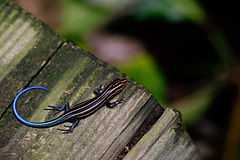Plestiodon
| Plestiodon | |
|---|---|
 | |
| Plestiodon fasciatus | |
| Scientific classification | |
| Kingdom: | Animalia |
| Phylum: | Chordata |
| Subphylum: | Vertebrata |
| Class: | Reptilia |
| Order: | Squamata |
| Suborder: | Lacertilia |
| Infraorder: | Scincomorpha |
| Family: | Scincidae |
| Genus: | Plestiodon A.M.C. Duméril & Bibron, 1839 |
Plestiodon is the name for a genus of lizards formerly referred to as Eumeces, except those now placed in Mesoscincus.
The genus Plestiodon are skinks (family Scincidae). They are secretive, agile animals with a cylindrical body covered with smooth, shiny scales.
Defensive mechanism
The conspicuous coloring is a survival trait: it attracts a predator’s attention to the tail of the animal, which will break off when grabbed. A skink thus often manages to escape and hide under some rock, log, or fallen leaves while the predator still contemplates the wildly thrashing severed tail. (This is an instance of what is called autotomy: voluntarily shedding a body part in order to escape, and later regenerating the body part.) After the tail regenerates, it usually has the same color as the rest of the body and is typically shorter than the original tail. In some species, regrown tails are pinkish. A regrown tail has a cartilaginous rod for support instead of vertebrae.
Reproduction
Plestiodon are all oviparous. The female lays eggs once a year after the breeding season in spring. The clutch size varies and is typically around 5 to 10 eggs. The hatchlings appear in late summer.
Thermoregulation
Like other reptiles, these skinks are "cold-blooded" — they are ectothermic animals: their metabolism cannot regulate their body temperature. To warm up, they often bask in the sun. In colder climates, they hibernate in winter in burrows below the frost line. In hot climates, they are active mainly in the morning and evening, staying under cover during the hottest hours of the day to avoid overheating.
Systematics
Recently two taxonomic revisions have been made regarding the 19th century genus Eumeces. They both resulted in similar results; the genus is paraphyletic and must be "sliced up" into several different genera. Griffith et al. (2000) proposed that the type species for Eumeces, E. pavimentatus, which is considered by many to be a subspecies of Eumeces schneideri, should be changed to Lacerta fasciata, so that the genus name Eumeces would stay with the most species-rich clade. However this petition has not been verified by the International Commission on Zoological Nomenclature. Schimtz et al. argued that Griffith et al. violated the Code and rejected the proposal on good grounds. Thus only the African species of the Eumeces schneideri group still belong to the genus Eumeces.
Within Eumeces the following species are recognized:
- Eumeces algeriensis
- Eumeces blythianus
- Eumeces schneideri
Some species that were formerly considered Eumeces have now been assigned to new genera:
Now in Plestiodon:
|
|
Now in Eurylepis:
- Eumeces indothalensis - now Eurylepis indothalensis
- Eumeces poonaensis - now Eurylepis poonaensis
- Eumeces taeniolatus - now Eurylepis taeniolatus
Now in Mesoscincus:
- Eumeces altamirani - now Mesoscincus altamirani
- Eumeces managuae - now Mesoscincus managuae
- Eumeces schwartzei - now Mesoscincus schwartzei
References
- Austin, J.J., and E.N. Arnold (2006). Using ancient and recent DNA to explore relationships of extinct and endangered Leiolopisma skinks (Reptilia: Scincidae) in the Mascarene islands. Molecular Phylogenetics and Evolution 39 (2): 503–511. doi:10.1016/j.ympev.2005.12.011 (HTML abstract)
- Griffith, H., A. Ngo and R.W. Murphy (2000). A cladistic evaluation of the cosmopolitan genus Eumeces Wiegmann (Reptilia, Squamata, Scincidae). Russ. J. Herpetol. 7 (1): 1-16.
- Schmitz, Andreas, Patrick Mausfeld and Dirk Embert. (2004). Molecular studies on the genus Eumeces Wiegmann, 1834: phylogenetic relationships and taxonomic implications. Hamadryad 28 (1-2): 73–89.
- Smith, H.M. (2005). Plestiodon: a Replacement Name for Most Members of the Genus Eumeces in North America. Journal of Kansas Herpetology (14): 15-16.
- Brandley, M.C., A. Schmitz and T.W. Reeder (2005). Partitioned Bayesian analyses, partition choice, and the phylogenetic relationships of Scincid lizards. Systematic Biology 54 (3): 373-390.
- Okamoto, Taku, Junko Motokawa, Mamoru Toda and Tsutomu Hikida (2006). Parapatric distribution of the lizards, Plestiodon (formerly Eumeces) latiscutatus and P. japonicus (Reptilia: Scincidae) around the Izu Peninsula, central Japan, and its biogeographic implications. Zoological Science 23: 419-425.
- Motokawa, Junko, and Tsutomu Hikida (2003). Genetic variation and differentiation in the Japanese five-lined skink, Eumeces latiscutatus (Reptile: Squamata). Zoological Science 20: 97-106.
External links
| Wikimedia Commons has media related to Plestiodon. |
| Wikispecies has information related to: Plestiodon |